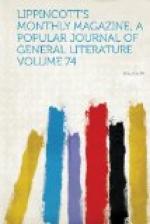While assimilation has been growing more complete, and a fixed resultant becoming more discernible, the ingredients of this ethnic medley do not seem to have materially varied in their proportions since the beginning of the century. They present a tolerably close parallel to the like process in Northern France, where Celt and Teuton combined in nearly equal numbers, with, as in our case, a limited local infusion of the Norse. The result cannot, however, be identical, the French lacking our Anglo-Saxon substratum, with its valuable traditions and habitudes of political thought. The balance between impulse and conservatism has never been, in this country, long or seriously disturbed, and is probably as sound now as a hundred years ago. In the discussions of the twenty years which embrace our Revolutionary period we find abundance of theory, but they were never carried by abstractions out of sight of the practical. Our publicists were not misled by convictions of the “infinite perfectibility of the human mind,” the motive proclaimed by Condorcet, writing in sweet obliviousness of the guillotine, as explaining “how much more pure, accurate and profound are the principles upon which the constitution and laws of France have been formed than those which directed the Americans.” The lack of this equilibrium among the pure, and, as we may venture to term them, the untrained races, we have occasional opportunities of noting on our own soil when for a passing cause they resort to isolated action.
[Illustration: The city of Tokyo, the largest steamship built in America, and FITCH’S steamboat, the first constructed.]
A race-question of a character that cannot be supplied by differentiation within Caucasian limits haunts us as it has done from the very birth of the colonies. Like the Wild Huntsman, we have had the sable spectre close beside us through the whole run. But, more fortunate than he, we see it begin to fade. At least its outlines are contracting. The ratio of colored inhabitants to the aggregate, in 1790 19.26 per cent., or one-fifth, fell in 1860 to 14.12, or




